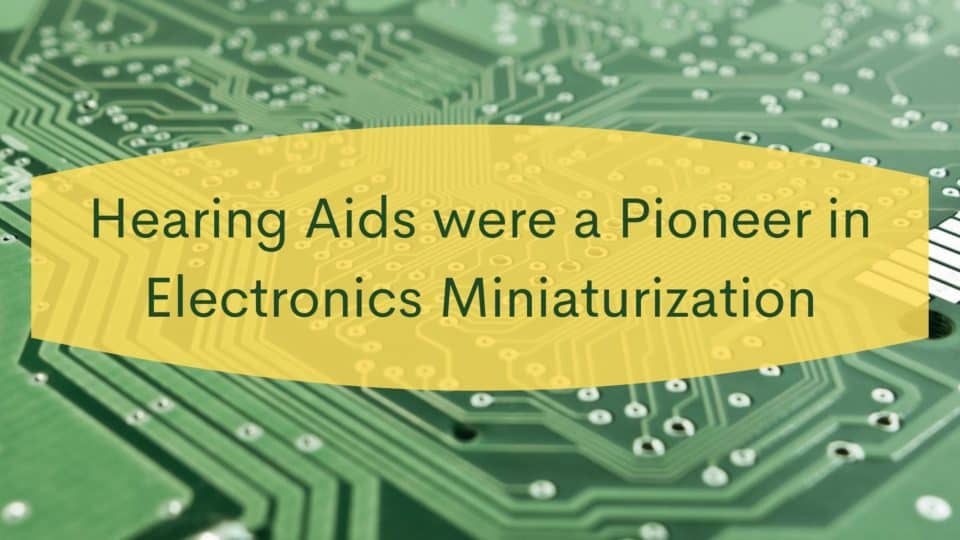- A Closer Look at Common Myths About Hearing Loss - May 7, 2024
- The Impact of Pets on Emotional and Hearing Health - April 26, 2024
- Strategies for Coping with Single-Sided Deafness - April 16, 2024
Technology has certainly come a long way. Only a few decades ago, where it would have been unfathomable to hold a computer in the palm of your hand. Today we walk around with computers that fit in the palm of our hands (smartphones), on our wrists (smartwatches), and even in our ears – in the form of hearing aids!
The journey toward the miniaturization of computers has been a long one, and for those of us with hearing loss, it might be fascinating to learn that miniaturization has been strongly influenced by hearing needs!
The Social Stigma of Hearing Loss
Hearing loss is one of the most common chronic health conditions to affect people around the world, regardless of age. However, this has not stopped the social stigma attached to hearing loss. A common misconception is that having hearing aids, or hearing loss, makes you seem old and out of touch. However, the reality is that hearing aids allow people to stay connected and engaged!
While it is important to change this narrative, there has been a benefit to it. The stigma of hearing aids has pushed scientists, inventors, and the industry towards the creation of smaller and smaller computer processors. The smaller the hearing aids, the less noticeable they are, allowing people with hearing loss to amplify their hearing without having to be obvious about their use. From the market for tinier and more discreet hearing aids came technological advancements which have allowed for smartphones, fitness bands, mp3 players, and more.
The History of Hearing Assistance
It has been a long road towards the hearing aids we all listen to today. Long before electronics came into the picture, people have been using and investigating ways to enhance hearing impairments. As far back as the 17th century, people used hearing trumpets which they would hold up to the ear canal, to help amplify sound. Technology has advanced since then, however, it was the 20th century when hearing aids began to employ more electronics, which somewhat resemble what is the standard today. The transistor not only enabled hearing aids to be made smaller but allowed them to fit around or inside the ear canal. By 1950, hearing aids that fit inside the ear became available and widely popular.
Late 20th century: Analog to digital
As time went on hearing aid manufacturers were able to build transistors out of silicon, which allowed them to be crafted even smaller. By the 1960s the basic structure of the hearing aids we know today was introduced, featuring a microphone, an amplifier, and a battery. This technology relied on analog signals which functioned as a wave. The problem with this technology is that it created a lot of feedback, most likely contributing to hearing aids stigma, which we are now fighting to undo. It wasn’t until the 1980s that the digital signal processing chip was used in hearing aids technology. The beauty of digital technology is that it breaks the sound wave into segmented steps rather than a wave. This enables a clear sound at each step as a sound wave is rounded out to the closest step. This technology continued to grow and by 1996 the first fully digital hearing aid was introduced. Digital hearing aids are now the most common hearing aid on the market and allow hearing aid manufacturers to offer even smaller technology than ever before.
The Beauty of Digital Hearing Aids
Digital hearing aids offer control and subtlety for people with hearing loss at smaller sizes than ever before. Today’s digital hearing aids employ algorithms to enhance hearing to an individual’s needs. Now compatible with Smartphones, hearing aids can be adjusted virtually or by the user in real-time. This tiny technology can separate background sounds from the sounds you want to hear and prioritize one person’s voice that you want to hear, over other distracting conversations.
Finding the Best Hearing Aids for You
Today, finding hearing aids that are tiny and easy to use has become the standard. Technology continues to push forward hearing aids technology. While hearing loss is in most cases irreversible, today’s hearing aids are subtle and efficient enough that when you wear them, you can feel as though you can hear relatively the same as your peers with no hearing loss at all. To find out about the amazing, user-friendly benefits of hearing aids today, schedule an appointment with us. We can help find the best hearing aids for you and your needs.

